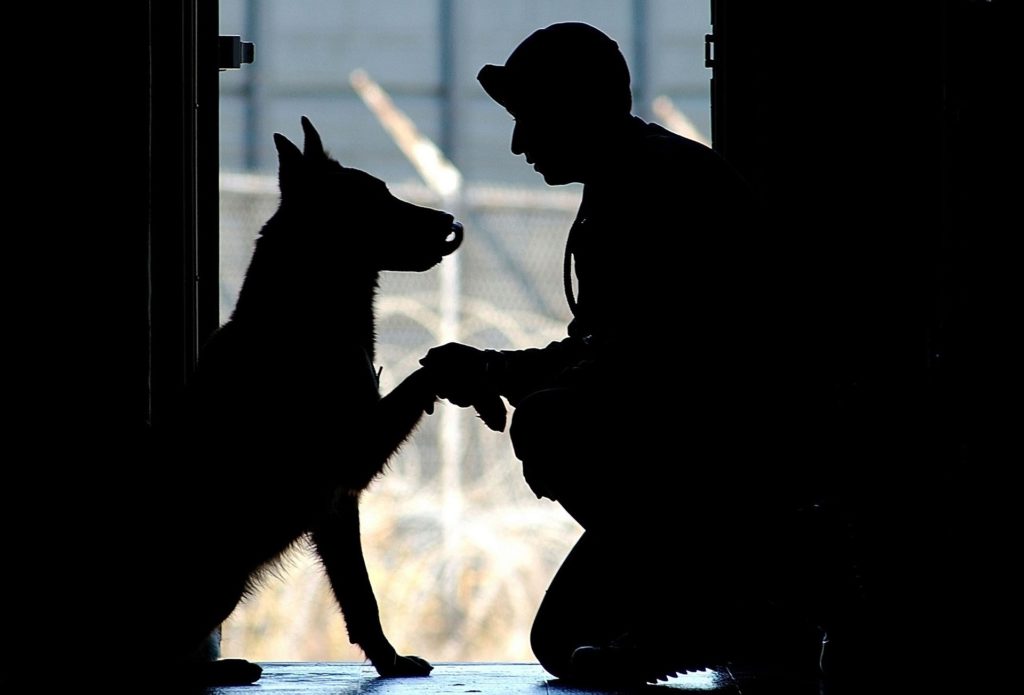
Disturbing and shocking experiences, such as combat duty, a serious accident, abuse or violence, or any number of life events can lead to post-traumatic stress disorder. The condition afflicts approximately eight million American adults each year, according to the U.S. Department of Veterans Affairs, but men and women of all ages and from all walks of life can be affected.
Symptoms of PTSD include recurring nightmares, intrusive thoughts, debilitating flashbacks and hypervigilance, which is a state of oversensitivity that can lead to self-destructive behavior under certain circumstances. In many cases, a trigger occurs that reminds an individual of the traumatic event or its effects. This acts as the unexpected “spark” that can cause one or more of the PTSD symptoms to flare up. PTDS can be a debilitating condition but also one where the afflicted can suffer alone, without help. This is where the benefits of service dogs and therapy animals come into play.
How do service dogs help?
When you are experiencing the often distressing symptoms of PTSD, additional issues could become part of the episode. These could include severe anxiety, overwhelming depression or a dissociative episode. A combination of symptoms can easily become debilitating and stop you in your tracks. A PTSD service dog could provide a close-by and accessible form of relief that can help you to become physically and mentally active again.
A specially trained service dog can nudge you to get moving and help you exit and recover from a PTSD episode. Therapy animals, although they are not trained as service dogs, can also provide a limited but welcome form of relief. They can be counted on to provide the type of companionship and unconditional love that can help bring you out of a “PTSD shell” when the symptoms cause you to withdraw.
When therapy animals interact with their owners, they can help counteract negative feelings that might come up. They also tend to be active and require regular walks and outdoor exercise, which can also contribute to a more positive outlook.
What do PTSD service dogs do?
A condition such as PTSD can leave you feeling detached or disassociated from your surroundings. A trained PTSD service dog, however, can guide you home if you experience a dissociative episode that leaves you disoriented. These service dogs can also enable you to feel more at ease in an uncomfortable social situation or help you get through a disturbing flashback. Your canine partner can even wake you up when it senses you are having a PTSD-related nightmare.
Specially trained service dogs can recognize and react to the symptoms exhibited by their owners’ PTSD, such as anxiety or stress. They also help with tasks such as reminding their owners when to take prescribed medications and, if needed, retrieve them.
To help lessen the chances of a stressful hypervigilance episode, a trained service dog can conduct searches of your home and also provide an added sense of comfort while you sleep at night. Overall, one of the most vital functions that a PTSD service dog performs for its owner is to disrupt a PTSD episode or anxiety attack. This is a particularly important role that they play in helping veterans who are recovering from highly stressful combat experiences. Statistics show that as many as 20 veteran suicides can occur on any given day.
What steps must be taken to qualify for a service dog?
If you’re thinking about how to get a service dog for PTSD, you should start by obtaining the required documentation from your health care provider. You will need to show proof that you were diagnosed with PTSD and your condition meets the criteria to qualify as a disability set by the Americans with Disabilities Act. The ADA defines a disability as “a physical or mental impairment that substantially limits one or more major life activities.”
The next step is partnering up with the right service dog. The dog must be a good fit to meet your individual needs. This can include characteristics such as the dog’s size, gait and temperament. An important factor in achieving a good match-up is the type of training the dog has received prior to your partnering with it.
There are various programs that can help pair you up with the right type of service dog to meet your needs. You can also train the dog yourself, but you must be able to bring about specific standards of canine training and behavior before you and your dog can lawfully act as a team in public places.
What breeds make the best PTSD service dogs?
With almost 350 dog breeds recognized internationally, you may wonder which are the best service dog breeds for PTSD. Basically, there are no specific breeds that have been “officially” recognized as being the most well-suited to relieving PTSD symptoms.
There are, however, certain breeds that have become popular service dog choices. In the case of owners with PTSD, the Golden and Labrador retriever breeds are popular. German shepherds are also chosen frequently. These breeds tend to be both well-tempered and intelligent. The Labrador retrievers are especially noted for being easily trained. Their large and reassuring presence can also help to calm an owner experiencing a severe panic or anxiety attack.
If you or a loved one are suffering from PTSD and are looking for an additional resource to help cope with the symptoms and improve day to day life, a service dog may be the right choice for you.
